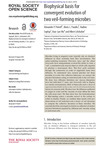Biophysical basis for convergent evolution of two veil-formingmicrobes
| dc.contributor.author | Petroff, Alexander P. | en_US |
| dc.contributor.author | Pasulka, Alexis L. | en_US |
| dc.contributor.author | Soplop, Nadine | en_US |
| dc.date.accessioned | 2016-10-11T05:37:07Z | |
| dc.date.available | 2016-10-11T05:37:07Z | |
| dc.date.issued | 2015 | en_US |
| dc.identifier.other | HPU4160640 | en_US |
| dc.identifier.uri | https://lib.hpu.edu.vn/handle/123456789/23527 | en_US |
| dc.description.abstract | Microbes living in stagnant water typically rely on chemical diffusion to draw nutrients from their environment. The sulfur-oxidizing bacterium Thiovulum majusand the ciliate Uronemellahave independently evolved the ability to form a ‘veil’, a centimetre-scale mucous sheet on which cells organize to produce a macroscopic flow. This flow pulls nutrients through the community an order of magnitude faster than diffusion. To understand how natural selection led these microbes to evolve this collective behaviour, we connect the physical limitations acting on individual cells to the cell traits | en_US |
| dc.format.extent | 14 p. | en_US |
| dc.format.mimetype | application/pdf | en_US |
| dc.language.iso | en | en_US |
| dc.subject | Biophysics | en_US |
| dc.subject | Ecology | en_US |
| dc.subject | Fluidmechanics | en_US |
| dc.subject | Hydrodynamics | en_US |
| dc.subject | Collective dynamics | en_US |
| dc.title | Biophysical basis for convergent evolution of two veil-formingmicrobes | en_US |
| dc.type | Article | en_US |
| dc.size | 1.40MB | en_US |
| dc.department | Education | en_US |
Files in this item
This item appears in the following Collection(s)
-
Education [806]

